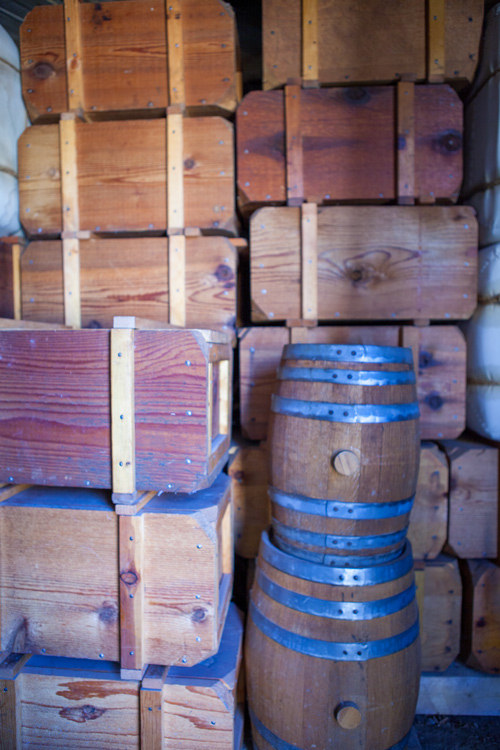The men use the day to pack the animal, plant, and mineral specimens, as well as Indian artifacts to be shipped from Fort Mandan on the barge. Two clerks from the N.W. Company ask the captains to pay for the two lost company horses the expedition borrowed last winter.
Expedition Stores
Fort Mandan Visitors Center

Taken with cooperation from the Fort Mandan Visitors’ Center. Photo © 2013 by Kristopher K. Townsend. Permission to use granted under the Creative Commons Attribution-Share Alike 4.0 International license.
Paying for Horses
Mrs. La Roche [Larocque] & McKinsey [McKenzie] Clerk to the N W. Compy. visit us. Mr. McKinzey wishes to get pay for his horse lost in our Service this winter and one of which our men were robed this winter by the Tetons, we Shall pay this man for his horse.
—William Clark (with an insertion by Lewis)
Jefferson’s Articles
The articles which was to be Sent back to the States in the Big Barge was packed and boxed up ready to go on board.
—John Ordway
Clark’s Journal
Fort Mandan April the 3rd 1805.
Sir [Thomas Jefferson]
. . . I take the liberty to send you for your own perusal the notes which I have taken in the form of a journal in their original state . . . . I most sincerely wish that leasure had permitted me to offer them in a more correct form.
. . . .
WM. CLARK[1]Clark to Jefferson. Donald Jackson, ed. Letters of the Lewis and Clark Expedition with Related Documents: 1783-1854, 2nd ed., (Urbana: University of Illinois Press, 1978), 230–231. See also … Continue reading
Celestial Observations
observed equal allitudes of the
with Sextant and artificial horizon
—William Clark
Weather Diary
State of Thermometer at rise
Weather Wind at rise
State of Thermometer at 4 P.M. Weather Wind at 4 P.M. State of the River 24 [above 0] fair N. 44 [above 0] fair W. fallen 5 in. frost last night
—William Clark and Meriwether Lewis[2]To assist the reader, the editor of this web page has omitted the date column, clarified the “State of the River” information, and spelled out some abbreviations.
Experience the Lewis and Clark Trail
The Lewis and Clark Trail Experience—our sister site at lewisandclark.travel—connects the world to people and places on the Lewis and Clark Trail.
Plan a trip related to April 3, 1805:

Fort Mandan is a High Potential Historic Site along the Lewis and Clark National Historic Trail managed by the U.S. National Park Service. The North Dakota Department of Parks and Recreation manages a modern reconstruction and the Lewis and Clark Interpretive Center located at US Hwy 83 and ND Hwy 200A.
Knife River Indian Villages National Historic Site is a High Potential Historic Site along the Lewis and Clark National Historic Trail managed by the U.S. National Park Service. A unit of the National Park System, the site is located at 564 County Road 37, one-half mile north of Stanton, North Dakota. It has exhibits, trails, and a visitor center.
Notes
| ↑1 | Clark to Jefferson. Donald Jackson, ed. Letters of the Lewis and Clark Expedition with Related Documents: 1783-1854, 2nd ed., (Urbana: University of Illinois Press, 1978), 230–231. See also Lewis’s contributions in a draft of this letter in Letters, 226. |
|---|---|
| ↑2 | To assist the reader, the editor of this web page has omitted the date column, clarified the “State of the River” information, and spelled out some abbreviations. |


